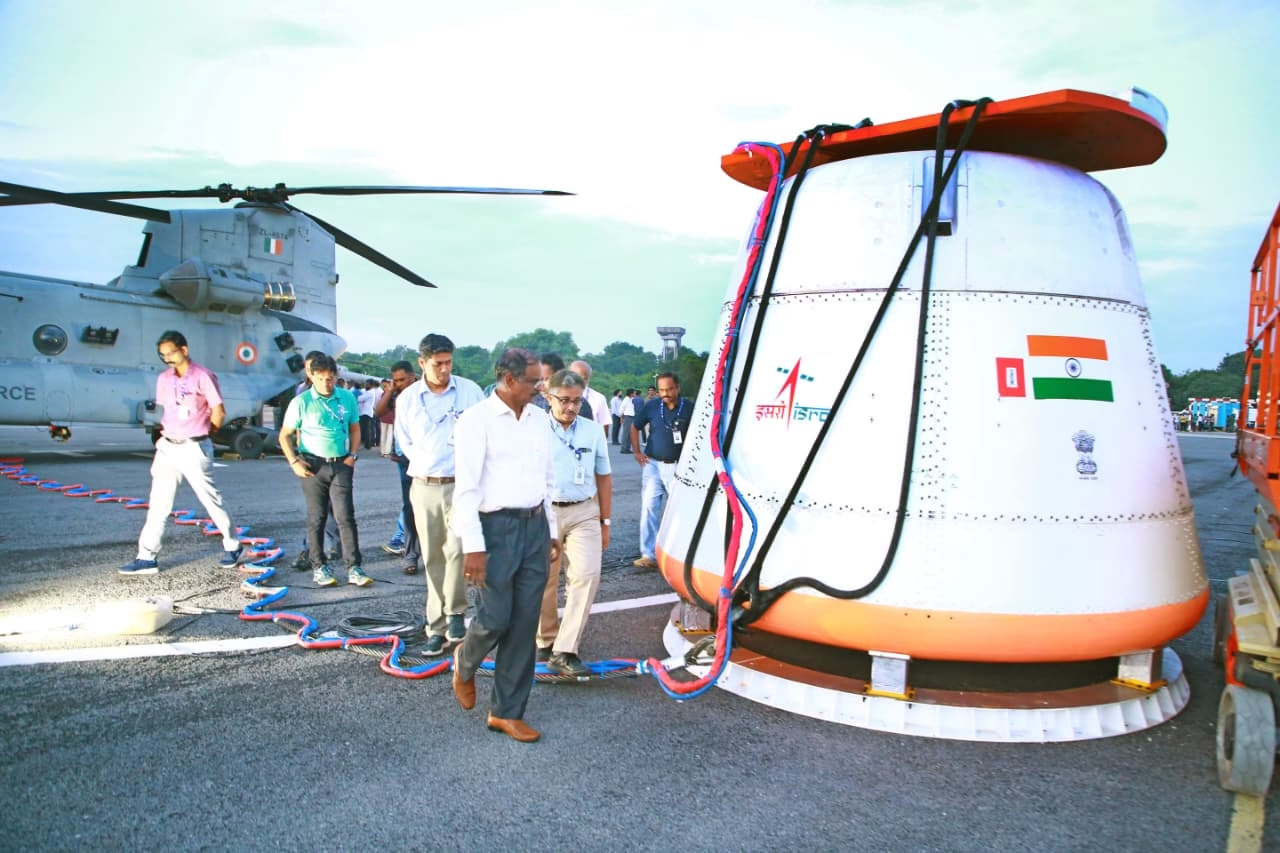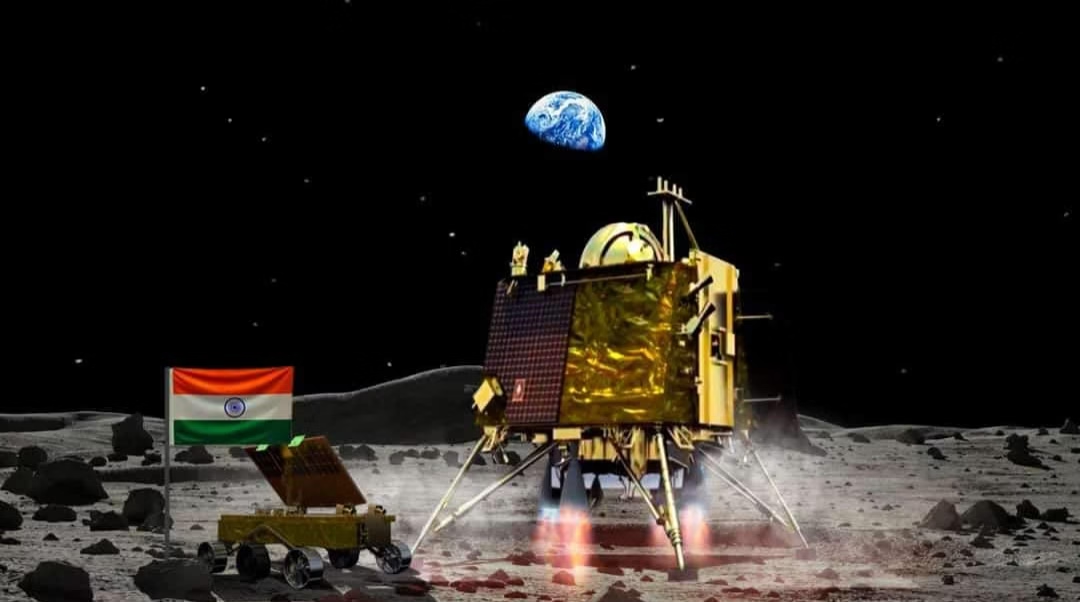ISRO First Integrated Air Drop Test (IADT-01): India today successfully conducted its first Integrated Air Drop Test (IADT-01) for Gaganyaan, validating the parachute-based deceleration system with support from IAF, DRDO, Navy, and Coast Guard. A key milestone ensuring astronaut safety in India’s human spaceflight mission.

India Successfully Conducts ISRO First Integrated Air Drop Test (IADT-01) for Gaganyaan: A Historic Step Toward India’s First Human Spaceflight
India’s ambitious Gaganyaan mission, which aims to send Indian astronauts to space aboard an indigenously developed spacecraft, has reached another critical milestone. On 24 August 2025, the Indian Space Research Organisation (ISRO) successfully accomplished its first Integrated Air Drop Test (IADT-01), an end-to-end demonstration of the parachute-based deceleration system that will ensure the safe return of astronauts during future missions.
This achievement is not just a technological validation but also a symbolic moment in India’s journey from ancient sky-watchers to modern-day spacefarers. The test stands as a testament to the country’s collaboration across multiple defense and research organizations, with the Indian Air Force, DRDO, Indian Navy, and Indian Coast Guard working alongside ISRO.
The story of IADT-01 is more than a technical update. It is a tale of engineering brilliance, teamwork, and the pursuit of a dream that began decades ago—the dream of seeing Indian astronauts fly safely into space and return home on India’s own spacecraft.
The Vision Behind Gaganyaan: ISRO First Integrated Air Drop Test (IADT-01)
Announced by the Government of India in 2018, Gaganyaan is India’s first human spaceflight mission, designed to send a crew of two to three astronauts into low Earth orbit (LEO) for a period of about three days, before bringing them back safely.
For such a mission, crew safety is paramount. Every phase—from launch to orbit to re-entry—demands multiple layers of security and redundancy. Among these, the parachute-based deceleration system plays a vital role. Once the crew module re-enters Earth’s atmosphere, it needs to slow down from supersonic speeds to ensure a soft and safe splashdown in the ocean. This is where the IADT-01 test becomes crucial.
What is the Integrated Air Drop Test (IADT-01)?
The Integrated Air Drop Test is a large-scale experiment designed to validate the end-to-end performance of parachute systems under realistic conditions. During IADT-01, a full-scale mock-up of the Gaganyaan crew module was lifted by an Indian Air Force transport aircraft to a high altitude.
Once released, the module free-fell before a series of parachutes deployed in a carefully sequenced manner to slow down its descent. The test demonstrated:
- Deployment of drogue parachutes for initial stabilization
- Firing of pilot chutes to pull out the main parachutes
- Opening of multiple main parachutes to distribute load evenly
- Final descent and splashdown into a pre-designated zone
This chain of events mimics what will actually happen when the Gaganyaan crew module re-enters Earth’s atmosphere with astronauts onboard.
A Joint Effort Across India’s Defense and Research Agencies: ISRO First Integrated Air Drop Test (IADT-01)
What makes IADT-01 particularly special is the collaboration it represents. The test involved the Indian Space Research Organisation (ISRO) at the helm, supported by:
- Indian Air Force (IAF): Provided the transport aircraft and operational expertise for lifting and dropping the test module.
- Defence Research and Development Organisation (DRDO): Contributed advanced parachute systems and safety validation technologies.
- Indian Navy: Assisted in planning and execution of splashdown operations, ensuring maritime recovery capability.
- Indian Coast Guard: Supported recovery logistics and provided ocean-based safety measures.
This synergy between space, air, and naval forces illustrates India’s integrated approach to national space endeavors.
Storytelling the Test: From Takeoff to Splashdown
At dawn, engineers, scientists, and defense personnel gathered at the test site with anticipation. The air buzzed with tension and excitement. The massive transport aircraft, carrying the Gaganyaan test module secured inside, roared across the runway.
As the plane reached its designated altitude, all eyes were on the skies. At the command, the crew module was released. For a moment, silence fell—the module appeared as though in free fall, plummeting toward Earth. Then, like a carefully choreographed ballet, the parachutes came to life.
First, the drogue chutes deployed, arresting the violent spin and stabilizing the descent. Seconds later, the pilot chutes ejected, pulling the larger canopies out into the rushing wind. Finally, the massive orange-and-white main parachutes blossomed in the sky, billowing against the blue backdrop.
The module slowed gracefully, drifting downward before splashing into the sea with a controlled impact. Recovery vessels from the Navy and Coast Guard quickly moved in, securing the test article and retrieving valuable telemetry.
For the teams on the ground, the sight was more than data—it was a vision of India’s future astronauts descending safely back to Earth after their historic journey.
Why This Test Matters: ISRO First Integrated Air Drop Test (IADT-01)
The IADT-01 is critical because:
- Crew Safety: Demonstrates that the parachute system will reliably slow down the crew module from high speeds.
- System Redundancy: Validates multiple parachute deployments, ensuring astronaut safety even if one parachute fails.
- Operational Readiness: Tests the recovery chain—from aerial release to naval retrieval—under real-world conditions.
- Boost to Confidence: Each successful trial builds confidence for the eventual crewed Gaganyaan mission.
The Road Ahead for Gaganyaan: ISRO First Integrated Air Drop Test (IADT-01)
With IADT-01 complete, ISRO and its partners will continue refining systems. Upcoming milestones include:
- Pad Abort Tests: To demonstrate crew escape in case of a launch emergency.
- Uncrewed Test Flights: Launching a human-rated capsule without astronauts to validate every mission sequence.
- Life Support Validation: Ensuring crew modules provide breathable air, thermal control, and safety for days in orbit.
- Recovery Rehearsals: Training Navy and Coast Guard teams for real astronaut recovery in the Indian Ocean.
The target for the first crewed Gaganyaan mission is mid-2026, although uncrewed flights will precede it to ensure every parameter is validated.
India’s Space Legacy: From Aryabhatta to Gaganyaan
The successful IADT-01 is a continuation of India’s long legacy in space. From the launch of Aryabhatta, India’s first satellite, in 1975, to the Chandrayaan and Mangalyaan missions, ISRO has proven its ability to achieve ambitious goals with precision and cost-efficiency.
Now, with Gaganyaan, India is preparing to join the elite club of nations—alongside the US, Russia, and China—that have independently sent humans to space.
Human Touch: Behind the Test
While headlines focus on parachutes and engineering, the heart of IADT-01 lies in the people. Young engineers fresh out of university stood shoulder to shoulder with veteran scientists. Air Force pilots, Navy divers, and Coast Guard sailors worked beyond their silos, bound by a shared vision.
Every bolt tightened, every parachute folded, every telemetry signal monitored was a reflection of countless hours of dedication. For many, it was more than a job—it was a contribution to India’s first step toward becoming a human spacefaring nation.
https://x.com/isro/status/1959528237484376542?t=sG6EaIRrFjCjifpNevHa4Q&s=19
Global Context and Significance: ISRO First Integrated Air Drop Test (IADT-01)
Internationally, the success of such tests bolsters India’s reputation as a rising space power. As private companies like SpaceX and Blue Origin dominate headlines, ISRO demonstrates that national space agencies can still compete with cost-effective and reliable technology.
Moreover, the Gaganyaan program lays the foundation for India’s long-term goals:
- Building the Bharatiya Antariksh Station (BAS) in the 2030s.
- Participating in international lunar exploration missions.
- Creating a robust ecosystem for private spaceflight and industry growth.
Conclusion: ISRO First Integrated Air Drop Test (IADT-01)
The successful Integrated Air Drop Test (IADT-01) is a giant leap for the Gaganyaan program and India’s dream of human spaceflight. It validates the parachute deceleration system that will bring future astronauts home safely. More than a technical feat, it is a story of teamwork, perseverance, and India’s vision for space exploration.
As ISRO, the Indian Air Force, DRDO, Navy, and Coast Guard celebrate this milestone, the world watches India inch closer to making history—sending its own citizens to space on its own rocket, and bringing them back safely.
Gaganyaan is no longer just a dream; with every test like IADT-01, it is becoming a reality.
FAQs on ISRO First Integrated Air Drop Test (IADT-01) for Gaganyaan
Q1. What is the Integrated Air Drop Test (IADT-01) conducted by ISRO?
The IADT-01 is a test where a simulated crew module was dropped from an aircraft to validate the parachute-based deceleration and recovery system that will be used in Gaganyaan missions. It ensures astronauts can return safely after spaceflight.
Q2. Why is the parachute-based deceleration system important for Gaganyaan?
The parachute system slows down the re-entering crew module from supersonic speeds, allowing for a safe splashdown or landing. Without it, the high velocity could endanger astronauts and the spacecraft structure.
Q3. Which organizations collaborated in the IADT-01 test?
ISRO worked jointly with the Indian Air Force, Defence Research and Development Organisation (DRDO), Indian Navy, and Indian Coast Guard to complete this critical milestone.
Q4. How was the IADT-01 test carried out?
A prototype crew module was lifted by an Indian Air Force aircraft and released mid-air. The parachute system deployed sequentially, decelerating the module until it safely landed in the designated area, where recovery teams were waiting.
Q5. How does this test help the Gaganyaan mission?
The successful IADT-01 proves that India’s parachute recovery system works as planned. This adds confidence in astronaut safety during re-entry and brings ISRO closer to its first human spaceflight mission.
Q6. Where was the IADT-01 conducted?
The test was conducted at a defense airbase, with recovery operations carried out by the Indian Navy and Coast Guard in coordination with ISRO’s mission teams.
Q7. When is the Gaganyaan mission expected to launch?
ISRO has planned a series of validation missions before the final human spaceflight. The first crewed Gaganyaan mission is expected within the next few years, depending on the outcomes of these preparatory tests.
Q8. How many parachutes are used in the Gaganyaan recovery system?
The system is designed with multiple parachutes, including drogue chutes and main chutes, ensuring redundancy and maximum safety for astronauts during descent.
Q9. What role did the Navy and Coast Guard play in the test?
The Indian Navy and Coast Guard were responsible for tracking, recovery, and safety during the air drop operation, ensuring the module was retrieved after landing.
Q10. How significant is this achievement for India’s space program?
This is a critical milestone proving India’s capability to design and validate complex human spaceflight systems. It strengthens India’s position as one of the few nations working towards independent crewed missions.

